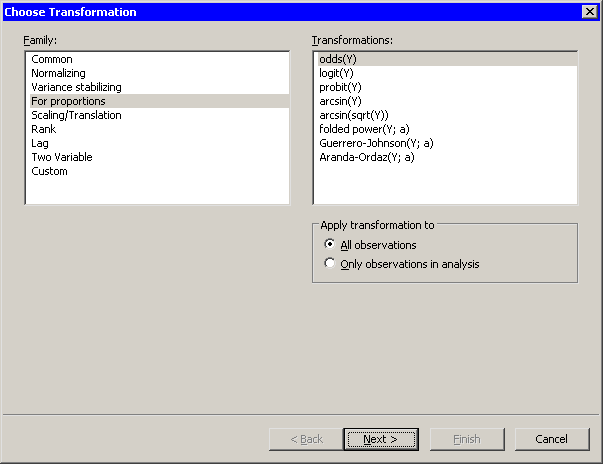Variable Transformations
Transformations for Proportion Variables
Figure 32.14 shows the transformations that are available when you select from the list. These transformations are intended for variables that represent proportions. That is, the Y variable must take values between 0 and 1. You can also use these transformations for percentages if you first divide the percentages by 100.
Chapter 7 of Atkinson (1985) is devoted to transformations of proportions. Equations for these transformations are given in Table 32.4.
Figure 32.14: Transformations for Proportions

Table 32.4: Description of Transformations for Proportions 
|
Default |
Name of |
||
|---|---|---|---|
|
Transformation |
Parameter |
New Variable |
Equation |
|
odds(Y) |
Odds_Y |
|
|
|
logit(Y) |
Logit_Y |
|
|
|
probit(Y) |
Probit_Y |
|
|
|
arcsin(Y) |
Arcsin_Y |
|
|
|
arcsin(sqrt(Y)) |
Angular_Y |
|
|
|
folded power(Y;a) |
MLE |
FPow_Y |
See text. |
|
Guerrero-Johnson(Y;a) |
MLE |
GJ_Y |
See text. |
|
Aranda-Ordaz(Y;a) |
MLE |
AO_Y |
See text. |
The probit function is the quantile function of the standard normal distribution.
The last three transformations in the list are similar to the Box-Cox transformation described in the section Normalizing Transformations. The parameter for each transformation is in the unit interval: ![$a\in [0,1]$](images/imlsug_ugvartransform0036.png) . Typically, you choose a parameter that maximizes (or nearly maximizes) a log-likelihood function.
. Typically, you choose a parameter that maximizes (or nearly maximizes) a log-likelihood function.
The log-likelihood function is defined as follows. Let N be the number of nonmissing values, and let  be the geometric mean function. Each transformation has a corresponding normalized transformation
be the geometric mean function. Each transformation has a corresponding normalized transformation  , to be defined later. Define
, to be defined later. Define
![\[ R(\lambda ;\bm {z}) = \bm {z}’\bm {z} - \left(\Sigma z_ i \right)^2 / N \]](images/imlsug_ugvartransform0023.png)
and define the log-likelihood function as
![\[ L(\lambda ;\bm {z}) = -(N/2) \log (R(\lambda ;\bm {z})/(N-1)) \]](images/imlsug_ugvartransform0024.png)
The following sections define the normalized transformation for the folded power, Guerrero-Johnson, and Aranda-Ordaz transformations.
In each section,  .
.




